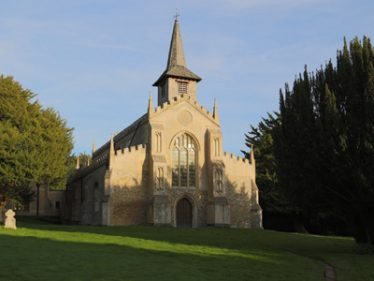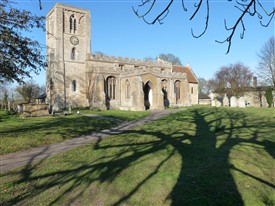Discord in the Affairs of the Parish, 1843



Introduction
In 1843 a case came before the Nisi Prius Court (part of the Assize court system dealing with civil cases) involving a legal dispute between the vicar of Holy Trinity, Meldreth, Rev William Totton, and his curate, Rev Belany.
Messrs Kelly, Andrews, Sergeant Byles and Mr Saunders appeared for the plaintiff and Mr Sergeant Storks and Mr Gunning for the defendant. A Special Jury was sworn in for the occasion. The Cambridge Independent Press of 25th March 1843 reported the proceedings as follows:
‘From the statement of Mr Kelly…the plaintiff (Belany) became curate of Meldreth in 1840. The defendant (Totton) was the vicar of Meldreth and rector of Debden in Essex and a man of fortune.
It appeared that there was a great spirit of contention and religious difference in the parish; some of the parishioners being of the opinion that the clergyman should preach in a surplice with the church doors open and that there should be a service every day; others were of a contrary opinion. It would seem that the plaintiff was favourable to the former party.
The Action
He left the parish in 1842. The action was brought, in slander, for a letter written by the plaintiff (Note: this seems to have been reported in error: the plaintiff in the case, as the person who brought the action, was the curate, Rev Belany. However, the letter is addressed from Debden in Essex and was clearly written by Rev Totton, the defendant) to Mr Spark, of Meldreth, which contained, amongst other things the following passage:
“My Dear Mr Spark
I beg you will excuse the trouble of this letter but I have long known your family and received you at my house; I would rather address you on the affairs of the parish than any other person. I truly lament the present discordant state of the parish, and which I wish I could remedy.
I have just engaged a gentleman, a very serious person, but I must say that Mr Belany, under the influence of a vile spirit of rancour and revenge, industriously foments strife and discord, so that no harmony can be reached, or continue to exist. It is most unchristian conduct and unbecoming of a minister of the gospel of peace. He is, however, what I always considered him to be, a papist in disguise, and would gladly have converted the whole parish to his opinions.”
Mr Serjeant Storks addressed the Jury for the defendant. The Jury returned a verdict for the plaintiff: damages, 40 shillings.’
The Victoria County History of the County of Cambridgeshire and the Isle of Ely, Volume 8, 1982, confirms that Rev Totton, a graduate of Oriel College, Oxford and vicar at Meldreth for 56 years, was not resident in the parish, having another living at St Mary and All Saints, Debden, near Saffron Walden:
“William Totton, vicar 1794– 1850, also held Debden (Essex) from 1796. He lived there in 1807, being licensed for non-residence, and employing at Meldreth a curate who also served at Melbourn. Meldreth therefore had only one Sunday service. There were quarterly communions, but only four or five communicants. By 1825 the resident curate held two Sunday services with sermons, and c.18 or 20 attended the quarterly sacraments. In 1836 there were few members of the established church and in 1851 only c.65 adults and 25 Sunday school pupils attended services.” (British History Online)
The question of whether a Minister of the Church of England should wear a white surplice while preaching was the subject of serious theological dispute at the time. The white surplice was a symbol of purity and standard wear for those officiating in Anglican worship but, according to custom, the priest was supposed to take off the surplice before climbing into the pulpit to preach and to put on a black preaching gown. This symbolised the transition from leading the liturgy (act of worship) to preaching the Word. Others, known as the ‘Ritualists’, argued that clergymen should still wear the surplice while preaching to show that preaching was part of liturgy. Whatever the theological niceties, the issue aroused strong feelings within the Anglican congregation and, in the winter of 1844-45, there were riots in the diocese of Exeter when a curate continued to wear the surplice while preaching and was mobbed by a crowd of 2,000 people (The Victorian Clergyman, Trevor May, 2008).
Note: the significance of the reference to preaching ‘with the church doors open’ is not known. Can anyone can throw any light on this?
Though unrelated to the case above, we know (from material held at the National Archives, Kew) that Rev William Totton, whilst rector at Debden, petitioned on behalf of Peter Richardson who was convicted at the Suffolk Summer Assizes in 1820 for the theft of a lamb. He was originally sentenced to death but this was commuted to life imprisonment and he was transported to Australia. Reports indicated that Richardson had worked to the complete satisfaction of his employer in New South Wales and the minister petitioned that he be allowed to return home to be reunited with his wife and children. However, Rev Totton was mistaken in his belief that the prisoner had been transported for a 14 year term and the petition was refused; the governor of New South Wales did not think he would be justified in recommending the free pardon of a convict who had been transported for life. (The National Archives, Kew: HO17/45/124, September 10th and 15th, 1829).





No Comments
Add a comment about this page